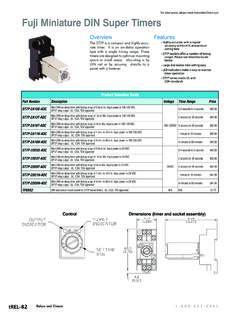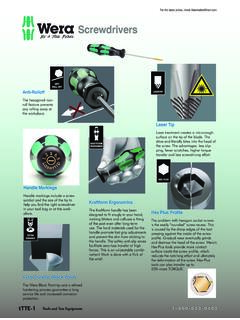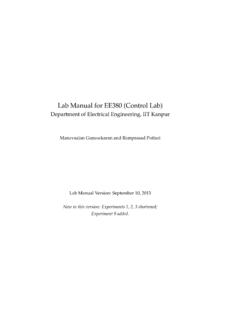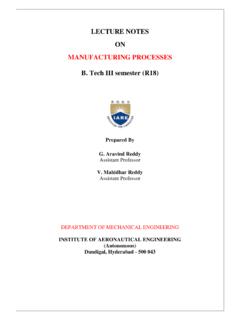Transcription of Automation 101: An Industry Guide To Control System ...
1 Automation 101: An Industry Guide To Control System Engineering A Condensed Guide to Automation Control System Specification, Design and Installation A Publication of Version TABLE OF. CONTENTS. Introduction Chapter 1 ------------ Consider Safety First Chapter 2 ------------ Identifying Processes for Automation Chapter 3 ------------ Specify Devices Chapter 4 ------------ Design Chapter 5 ------------ Build Chapter 6 ------------ Install and Start-up Chapter 7 ------------ Maintain Additional Resources f t in 2. Introduction The following is a general Guide to the specification, design and installation of automated Control systems.
2 The information and references are presented in a logical order that will take you from the skills required to recognize an operation or process that may be suited for automating, to tips on setting up a program to maintain the Control System . Whether an expert or a novice at electrical Control devices and systems, the information presented should give you a check list to use in the steps to implementing an automated Control System . The engineer's first problem in any design situation is to discover what the . problem really is. - Unknown f t in 3.
3 CHAPTER. 1. Consider Safety First 4. Safety 4 Things to Consider The first most important item to consider before attempting an automated Control System , or even a simple on/off Control for a pump, is safety, both for personnel that may be working with or near the automated equipment, as well as to prevent damage to the equipment. To minimize the risk of potential safety problems, you should follow all applicable local, state and national codes that regulate the installation and operation of your Control System , along with the equipment or process it is designed to Control .
4 These codes vary by area and usually change over time, constantly being reviewed and updated. It will be your responsibility to determine which codes should be followed and to verify that the equipment, installation, and operation is in compliance with the latest revision of these codes. It would be wise to educate yourself as much as possible about electricity and electrical equipment in general. A good understanding of basic electricity, including DC and AC theory and practice, Ohm's Law, etc. will go a long way in helping you understand the various codes and standards.
5 Want to learn some basic principles of electricity? We cover the basics of DC and AC theory, Ohm's Law, Kirchoff's Laws, and more in our blog post entitled Basic Electrical Theory . Visit to read more! f t in 5. 1. Avoid Endangering Your Personnel Most likely your Control System will be dealing with electrical energy, so your first goal will be to eliminate the risk of fire and electrical shock to personnel. At a minimum, you should follow all applicable sections of these two organizations. National Fire Protection Association (NFPA) fire code National Electrical Manufacturer's Association (NEMA).
6 Some pertinent sections are: o ICS 1: General Standards for Industrial Control and Systems o ICS 3: Industrial Systems o ICS 6: Enclosures for Industrial Control Systems Please keep in mind that if the automated Control System you are developing needs to be accepted in the international market, the National Electrical Code (NEC), as a publication of NFPA, is being harmonized with the International Electrotechnical Commission (IEC) (Website: ). and the European Hazardous Location Ratings. For more information, check the Instrument Society of America's (ISA) Website at Additional resources on the subject can be found at f t in 6.
7 2. Lockout/Tagout Another area of safety that needs to be considered for automated Control systems is lockout/tagout procedures as specified by Occupational Safety and Health Administration (OSHA). "Lockout/tagout" refers to specific practices and procedures to safeguard operators and maintenance personnel from the unexpected energization or startup of machinery and equipment, or the release of hazardous energy during service or maintenance activities. In order to have your Control System make use of a lockout/tagout procedure, the design should include the ability to shut off, neutralize, or isolate any energy source, such as the main electrical feed, but also any pneumatic, hydraulic or mechanical energy storage device.
8 The means to do this should be considered in the initial design of the automated Control System . Additional information can be found on OSHA's Website. 3. Avoiding Device Failures There are many reasons why the electrical devices that you will use in the design of your automated Control System should be listed, approved or registered with a testing laboratory. One reason is to ensure that the device meets standards that will prevent failure that could cause catastrophic results. Another reason might be for insurance or compliance purposes.
9 One of the most specified and premier safety testing laboratories is Underwriters Laboratories (UL). The most applicable area of interest for Control systems is UL's Standard for Safety 508A. If your Control System panel requires being built to UL508A, then you will need to contract directly with UL to become a UL508A panel builder or use an existing UL508A panel builder. Compliance to UL508A for products can be found on our Website at f t in 7. 4. Other Safety Considerations Emergency Stop The Control System must provide a quick manual method of disconnecting all System power to the machinery, equipment or process.
10 The disconnect device or switch must be clearly labeled Emergency Stop . Accidental Powering of Outputs - Do not rely on the Automation Control System alone to provide a safe operating environment. You should use external electromechanical devices, such as relays or limit switches that are independent of any electronic controlling device, such as a solid state relay or a PLC (Programmable Logic Controller) output module , to provide protection for any part of the System that may cause personal injury or damage. These devices should be installed in a manner that prevents any machine operations from occurring unexpectedly.












